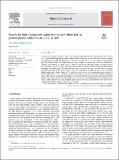Search for dijet resonances using events with three jets in proton-proton collisions at √s=13 TeV
Author(s)
The CMS Collaboration; Abercrombie, Daniel Robert; Allen, Branden; Baty, Austin Alan; Bi, Ran; Brandt, Stephanie Akemi; Busza, Wit; Cali, Ivan Amos; D'Alfonso, Mariarosaria; Gomez-Ceballos, Guillelmo; Goncharov, Maxim; Harris, Philip Coleman; Hsu, David; Hu, Miao; Klute, Markus; Kovalskyi, Dmytro; Lee, Y.-J.; Luckey Jr, P David; Maier, Benedikt; Marini, Andrea Carlo; McGinn, Christopher Francis; Mironov, Camelia Maria; Narayanan, S.; Niu, Xinmei; Paus, Christoph M. E.; Rankin, Dylan S.; Roland, Christof E; Roland, Gunther M; Shi, Z.; Stephans, George S. F.; Sumorok, Konstanty C; Tatar, Kaya; Velicanu, Dragos Alexandru; Wang, J.; Wang, T. W.; Wyslouch, Boleslaw; ... Show more Show less
DownloadPublished version (788.9Kb)
Publisher with Creative Commons License
Publisher with Creative Commons License
Creative Commons Attribution
Terms of use
Metadata
Show full item recordAbstract
© 2020 The Author(s) A search for a narrow resonance with a mass between 350 and 700 GeV, and decaying into a pair of jets, is performed using proton-proton collision events containing at least three jets. The data sample corresponds to an integrated luminosity of 18.3 fb−1 recorded at s=13TeV with the CMS detector. Data are collected with a technique known as “data scouting”, in which the events are reconstructed, selected, and recorded at a high rate in a compact form by the high-level trigger. The three-jet final state provides sensitivity to lower resonance masses than in previous searches using the data scouting technique. The spectrum of the dijet invariant mass, calculated from the two jets with the largest transverse momenta in the event, is used to search for a resonance. No significant excess over a smoothly falling background is found. Limits at 95% confidence level are set on the production cross section of a narrow dijet resonance and compared with the cross section of a vector dark matter mediator coupling to dark matter particles and quarks. Translating to a model where the narrow resonance interacts only with quarks, upper limits on this coupling range between 0.10 and 0.15, depending on the resonance mass. These results represent the most stringent upper limits in the mass range between 350 and 450 GeV obtained with a flavor-inclusive dijet resonance search.
Date issued
2020Department
Massachusetts Institute of Technology. Department of Physics; Massachusetts Institute of Technology. Laboratory for Nuclear Science; Massachusetts Institute of Technology. Department of Aeronautics and AstronauticsJournal
Physics Letters, Section B: Nuclear, Elementary Particle and High-Energy Physics
Publisher
Elsevier BV